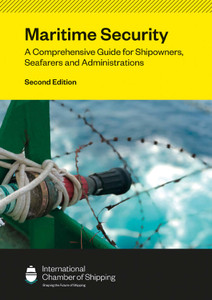
This publication provides guidance on how to combat drug trafficking at sea and how to recognise the signs of drug use and dependence among crew members.
Considered the leading industry publication on the topic, this 2025 - 2026 edition has been fully updated by industry experts to assist shipping companies, Masters and officers to prepare for, prevent, protect against and respond to drug trafficking and drug abuse at sea.
Use of these Guidelines can help to protect the shipping industry from the reputational and commercial damage that may be associated with drug incidents. They identify shipboard operational considerations and responses, as well as the training and procedures that should be in place both ashore and on board.
Fully updated and revised to incorporate the latest industry and regulatory guidance, topics covered include:
- Drug trafficking trends and patterns, as well as high-profile seizures and incidents
- physical security measures, both in port and on board ship
- training and education, including suggested training at both ship and corporate levels
- search procedures, including methods of searching and common concealment methods
- actions to be taken when drugs are found on board, including incident response reports and customs information.
These Guidelines provide essential guidance for shipping companies, ports, Masters, ships' officers, cargo owners, government officials, customs and the maritime industry as a whole.
Foreword
Drug trafficking is a huge criminal enterprise, involving enormous sums of money and a complex international network of often violent and highly organised cartels and gangs.
Commercial shipping, unfortunately, can unwittingly play a significant part in the transportation of illicit drugs to the places where they are consumed. The shipping industry therefore shares a collective responsibility to assist in combatting this illegal traffic. This requires shipping companies, and ships? crews, to be constantly aware of the possibility that ships, and the cargo they carry, may be used as a cover for drug smuggling. This is also a matter of enlightened self-interest. In the event that illegal drugs are found on board a ship by local customs or law enforcement agencies, companies and seafarers may potentially be exposed to huge financial fines or penalties, or even the risk of imprisonment.
Drug abuse also presents a serious threat to ships? crews, compounded by the direct connection between intravenous drug use and its associated health risks. Apart from the obvious impact of any illicit drug use on seafarers? health, it affects fitness for duty and compromises the safety of the ship. It also exposes crews to the wider consequences of being associated with serious criminal activity, a particular danger in those parts of the world where the strict rule of law cannot be taken for granted or where the death penalty for drug trafficking still applies.
These Guidelines are intended to help shipping companies, Masters and ships? officers to combat drug trafficking and to recognise some of the signs of possible drug use among crew members.
Cooperation with customs authorities is essential in fighting drug trafficking and, to that end, the International Chamber of Shipping (ICS) and the World Customs Organization (WCO) signed a Memorandum of Understanding more than 30 years ago on the principles of such cooperation. The International Conference on Drug Abuse and Illicit Trafficking, held under UN auspices in 1987, welcomed the adoption of such agreements and called upon organisations such as ICS to prepare ?standards or codes of conduct ... with a view to curbing the illicit traffic in drugs?. Guidelines setting out some of the ways in which shipping companies and customs authorities can cooperate were then drawn up in collaboration with the WCO, and the current edition of these Guidelines supplements this basic advice with more practical information, updated to reflect recent developments.
The latest edition of these Guidelines also includes a section on the implications of cyber risks for drug trafficking.
In the preparation of the current and previous editions of these Guidelines, ICS has sought advice from several sources. Particular acknowledgement is made to the UN Office on Drugs and Crime in Vienna, the WCO, and customs authorities in the United Kingdom, the United States and Hong Kong, China.
Attention is drawn to countries where cannabis possession for personal use has been legalised. This may conflict with the laws of the flag State of the ship that prohibits such onboard possession and, if this is the case, the flag State law will take precedence.
Comments on these Guidelines, and suggestions for improvement to any future edition, will be welcome and should be addressed to:
International Chamber of Shipping
7th Floor, Walsingham House
35 Seething Lane,
London EC3N 4AH.
United Kingdom
info@ics-shipping.org
Foreword
Section A - Preparation - Understanding the Security Challenges
Chapter 1 - Introduction
Chapter 2 - All Ports and Seas are Vulnerable
Chapter 3 - The Threat to Ships
Chapter 4 - Risk Management
Section B - Protection
Chapter 5 - Organisational Behaviour Leading to Enhanced Security Culture
Chapter 6 - Physical Security Measures
Chapter 7 - Cyber Security Measures
Section C - Prevention
Chapter 8 - National and International Cooperation
Chapter 9 - Training and Education
Chapter 10 - Penalties and Prosecution
Section D - Response
Chapter 11 - Tactical
Chapter 12 - Operational
Chapter 13 ? Actions When Drugs are Found
Section E - Recognition of Drugs
Chapter 14 - Drugs and Addiction
Chapter 15 - Alcohol and Addiction
Chapter 16 - Emerging Drug Trends
Chapter 17 - Drug Characteristics and Identification
Chapter 18 - Legitimate Packaged Chemical Cargoes
Reporting
Customs Authority Contacts
References
International Chamber of Shipping
The International Chamber of Shipping (ICS) is the principal international trade association for the shipping industry, representing shipowners and operators in all sectors and trades. ICS membership comprises national shipowners' associations in Asia, Europe and the Americas whose member shipping companies operate over 80% of the world's merchant tonnage.
Established in 1921, ICS is concerned with all technical, legal, employment affairs and policy issues that may affect international shipping.
ICS represents shipowners with the various intergovernmental regulatory bodies that impact on shipping, including the International Maritime Organization.
ICS also develops best practices and guidance, including a wide range of publications and free resources that are used by ship operators globally.
https://www.ics-shipping.org/about-ics/
Witherbys
Witherbys titles are developed using scripts developed by technical experts that are peer reviewed within work groups. Typically, they seek to improve understanding of the regulations, recommendations and guidelines issued by Industry.
Witherbys staff have significant expertise in the fields of navigation and hazardous cargoes as well as in the presentation of complex subjects in a graphic and easy to understand manner.
- Number of Pages:
- 250
- Published Date:
- April 2025
- Book Height:
- 297 mm
- Book Width:
- 210 mm
- Publication Date:
- April 2025
- Author:
International Chamber of Shipping and Witherbys
- Weight:
- 1.3 kg
- Preview:
- Yes





